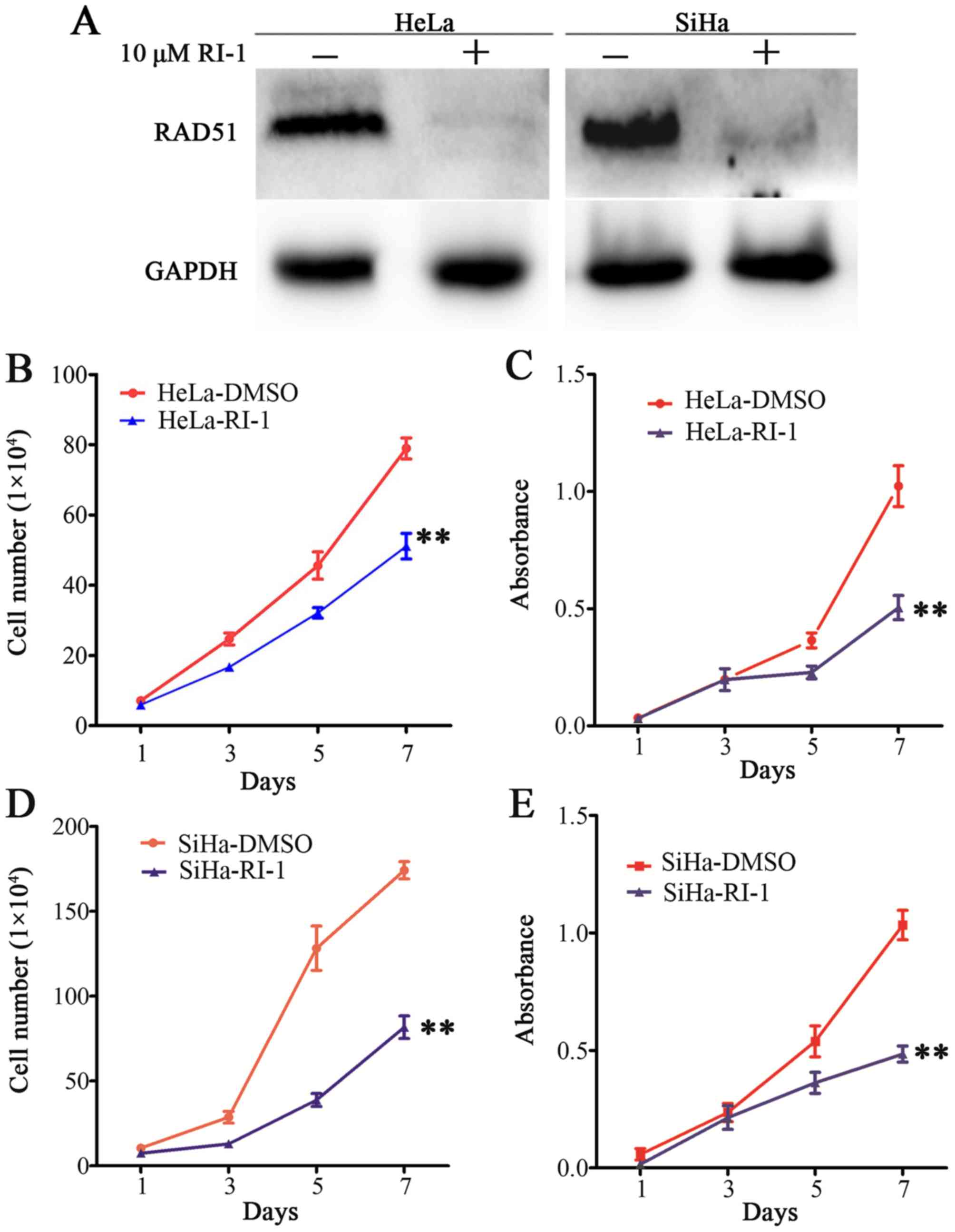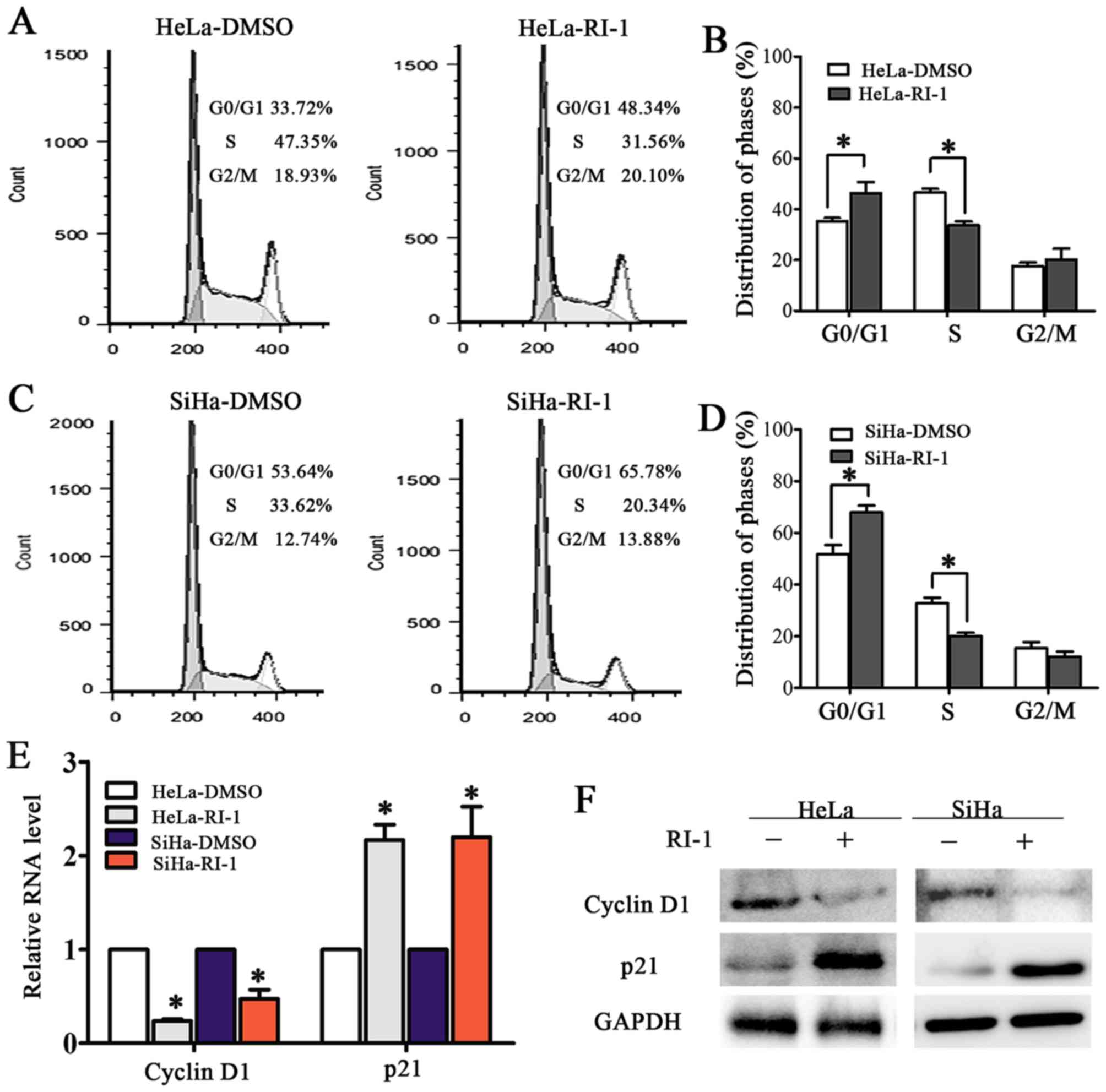|
1
|
Torre LA, Bray F, Siegel RL, Ferlay J,
Lortet-Tieulent J and Jemal A: Global cancer statistics, 2012. CA
Cancer J Clin. 65:87–108. 2015. View Article : Google Scholar : PubMed/NCBI
|
|
2
|
Walboomers JM, Jacobs MV, Manos MM, Bosch
FX, Kummer JA, Shah KV, Snijders PJ, Peto J, Meijer CJ and Muñoz N:
Human papillomavirus is a necessary cause of invasive cervical
cancer worldwide. J Pathol. 189:12–19. 1999. View Article : Google Scholar : PubMed/NCBI
|
|
3
|
Zhang L, Wu J, Ling MT, Zhao L and Zhao
KN: The role of the PI3K/Akt/mTOR signalling pathway in human
cancers induced by infection with human papillomaviruses. Mol
Cancer. 14:872015. View Article : Google Scholar : PubMed/NCBI
|
|
4
|
Qureshi R, Arora H and Rizvi MA: EMT in
cervical cancer: Its role in tumour progression and response to
therapy. Cancer Lett. 356:321–331. 2015. View Article : Google Scholar : PubMed/NCBI
|
|
5
|
Kowalczykowski SC: Biochemistry of genetic
recombination: Energetics and mechanism of DNA strand exchange.
Annu Rev Biophys Biophys Chem. 20:539–575. 1991. View Article : Google Scholar : PubMed/NCBI
|
|
6
|
Paulíková S, Chmelařová M, Petera J,
Palička V and Paulík A: Hypermethylation of RAD51L3 and XRCC2 genes
to predict late toxicity in chemoradiotherapy-treated cervical
cancer patients. Folia Biol (Praha). 59:240–245. 2013.PubMed/NCBI
|
|
7
|
Takenaka T, Yoshino I, Kouso H, Ohba T,
Yohena T, Osoegawa A, Shoji F and Maehara Y: Combined evaluation of
Rad51 and ERCC1 expressions for sensitivity to platinum agents in
non-small cell lung cancer. Int J Cancer. 121:895–900. 2007.
View Article : Google Scholar : PubMed/NCBI
|
|
8
|
Maacke H, Opitz S, Jost K, Hamdorf W,
Henning W, Krüger S, Feller AC, Lopens A, Diedrich K, Schwinger E,
et al: Over-expression of wild-type Rad51 correlates with
histological grading of invasive ductal breast cancer. Int J
Cancer. 88:907–913. 2000. View Article : Google Scholar : PubMed/NCBI
|
|
9
|
Liu G, Yang D, Rupaimoole R, Pecot CV, Sun
Y, Mangala LS, Li X, Ji P, Cogdell D, Hu L, et al: Augmentation of
response to chemotherapy by microRNA-506 through regulation of
RAD51 in serous ovarian cancers. J Natl Cancer Inst. 107:1072015.
View Article : Google Scholar
|
|
10
|
Maacke H, Jost K, Opitz S, Miska S, Yuan
Y, Hasselbach L, Lüttges J, Kalthoff H and Stürzbecher HW: DNA
repair and recombination factor Rad51 is over-expressed in human
pancreatic adenocarcinoma. Oncogene. 19:2791–2795. 2000. View Article : Google Scholar : PubMed/NCBI
|
|
11
|
Raderschall E, Stout K, Freier S, Suckow
V, Schweiger S and Haaf T: Elevated levels of Rad51 recombination
protein in tumor cells. Cancer Res. 62:219–225. 2002.PubMed/NCBI
|
|
12
|
Hine CM, Seluanov A and Gorbunova V: Use
of the Rad51 promoter for targeted anti-cancer therapy. Proc Natl
Acad Sci USA. 105:20810–20815. 2008. View Article : Google Scholar : PubMed/NCBI
|
|
13
|
Nagathihalli NS and Nagaraju G: RAD51 as a
potential biomarker and therapeutic target for pancreatic cancer.
Biochim Biophys Acta. 1816:209–218. 2011.PubMed/NCBI
|
|
14
|
Wang AT, Kim T, Wagner JE, Conti BA, Lach
FP, Huang AL, Molina H, Sanborn EM, Zierhut H, Cornes BK, et al: A
dominant mutation in human RAD51 reveals its function in DNA
interstrand crosslink repair independent of homologous
recombination. Mol Cell. 59:478–490. 2015. View Article : Google Scholar : PubMed/NCBI
|
|
15
|
Budke B, Logan HL, Kalin JH, Zelivianskaia
AS, McGuire Cameron W, Miller LL, Stark JM, Kozikowski AP, Bishop
DK and Connell PP: RI-1: A chemical inhibitor of RAD51 that
disrupts homologous recombination in human cells. Nucleic Acids
Res. 40:7347–7357. 2012. View Article : Google Scholar : PubMed/NCBI
|
|
16
|
Hong KJ, Hsu MC and Hung WC: RECK impedes
DNA repair by inhibiting the erbB/JAB1/Rad51 signaling axis and
enhances chemosensitivity of breast cancer cells. Am J Cancer Res.
5:2422–2430. 2015.PubMed/NCBI
|
|
17
|
Choudhury A, Zhao H, Jalali F, Al Rashid
S, Ran J, Supiot S, Kiltie AE and Bristow RG: Targeting homologous
recombination using imatinib results in enhanced tumor cell
chemosensitivity and radiosensitivity. Mol Cancer Ther. 8:203–213.
2009. View Article : Google Scholar : PubMed/NCBI
|
|
18
|
Kübler HR, van Randenborgh H, Treiber U,
Wutzler S, Battistel C, Lehmer A, Wagenpfeil S, Hartung R and Paul
R: In vitro cytotoxic effects of imatinib in combination with
anticancer drugs in human prostate cancer cell lines. Prostate.
63:385–394. 2005. View Article : Google Scholar : PubMed/NCBI
|
|
19
|
Wang B, Hou D, Liu Q, Wu T, Guo H, Zhang
X, Zou Y, Liu Z, Liu J, Wei J, et al: Artesunate sensitizes ovarian
cancer cells to cisplatin by downregulating RAD51. Cancer Biol
Ther. 16:1548–1556. 2015. View Article : Google Scholar : PubMed/NCBI
|
|
20
|
Cortez MA, Valdecanas D, Niknam S, Peltier
HJ, Diao L, Giri U, Komaki R, Calin GA, Gomez DR, Chang JY, et al:
In vivo delivery of miR-34a sensitizes lung tumors to radiation
through RAD51 regulation. Mol Ther Nucleic Acids. 4:e2702015.
View Article : Google Scholar : PubMed/NCBI
|
|
21
|
Ohnishi T, Taki T, Hiraga S, Arita N and
Morita T: In vitro and in vivo potentiation of radiosensitivity of
malignant gliomas by antisense inhibition of the RAD51 gene.
Biochem Biophys Res Commun. 245:319–324. 1998. View Article : Google Scholar : PubMed/NCBI
|
|
22
|
Mueller AC, Sun D and Dutta A: The miR-99
family regulates the DNA damage response through its target SNF2H.
Oncogene. 32:1164–1172. 2013. View Article : Google Scholar : PubMed/NCBI
|
|
23
|
Martinez SF, Renodon-Cornière A, Nomme J,
Eveillard D, Fleury F, Takahashi M and Weigel P: Targeting human
Rad51 by specific DNA aptamers induces inhibition of homologous
recombination. Biochimie. 92:1832–1838. 2010. View Article : Google Scholar : PubMed/NCBI
|
|
24
|
Parplys AC, Seelbach JI, Becker S, Behr M,
Wrona A, Jend C, Mansour WY, Joosse SA, Stuerzbecher HW, Pospiech
H, et al: High levels of RAD51 perturb DNA replication elongation
and cause unscheduled origin firing due to impaired CHK1
activation. Cell Cycle. 14:3190–3202. 2015. View Article : Google Scholar : PubMed/NCBI
|
|
25
|
Mitra A, Jameson C, Barbachano Y, Sanchez
L, Kote-Jarai Z, Peock S, Sodha N, Bancroft E, Fletcher A, Cooper
C, et al: IMPACT Steering Committee and IMPACT and EMBRACE
Collaborators: Overexpression of RAD51 occurs in aggressive
prostatic cancer. Histopathology. 55:696–704. 2009. View Article : Google Scholar : PubMed/NCBI
|
|
26
|
Ko JC, Wang TJ, Chang PY, Syu JJ, Chen JC,
Chen CY, Jian YT, Jian YJ, Zheng HY, Chen WC, et al: Minocycline
enhances mitomycin C-induced cytotoxicity through down-regulating
ERK1/2-mediated Rad51 expression in human non-small cell lung
cancer cells. Biochem Pharmacol. 97:331–340. 2015. View Article : Google Scholar : PubMed/NCBI
|
|
27
|
Deng C, Zhang P, Harper JW, Elledge SJ and
Leder P: Mice lacking p21CIP1/WAF1 undergo normal development, but
are defective in G1 checkpoint control. Cell. 82:675–684. 1995.
View Article : Google Scholar : PubMed/NCBI
|
|
28
|
Tashiro S, Walter J, Shinohara A, Kamada N
and Cremer T: Rad51 accumulation at sites of DNA damage and in
postreplicative chromatin. J Cell Biol. 150:283–291. 2000.
View Article : Google Scholar : PubMed/NCBI
|














